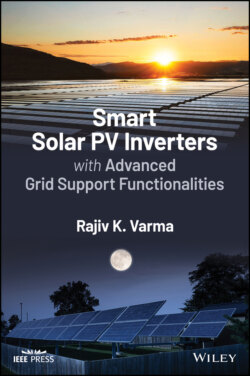Читать книгу Smart Solar PV Inverters with Advanced Grid Support Functionalities - Rajiv K. Varma - Страница 16
1 IMPACTS OF HIGH PENETRATION OF SOLAR PV SYSTEMS AND SMART INVERTER DEVELOPMENTS
ОглавлениеSolar Photovoltaic (PV) power systems are being integrated at an unprecedented rate in both bulk power systems and distribution systems worldwide. It is expected that by 2050, solar PV systems will provide about 35% of global electricity generation [1]. Different countries, and their provinces and states, are setting up ambitious targets for PV system installations up to 100% renewables with substantial share of solar PV systems. Several grid impact studies with 100% Inverter Based Resources (IBRs) and Distributed Energy Resources (DERs) with a major component of solar PV systems have already been performed [2, 3]. While these systems significantly help in reducing overall greenhouse gas emissions, they present unique integration challenges which need to be understood and mitigated to derive full benefits from their applications. The solar PV systems are based on inverters. Power electronics technology provides new “smart” capabilities to the inverters in addition to their primary function of active power generation. These capabilities not only help solar PV systems mitigate different adverse impacts of their integration but also provide several valuable grid support functions.
This chapter presents the concepts of reactive power and active power control, which form the basis of smart inverter operation. The impact of such controls on system voltage and frequency is explained. The different challenges of integrating solar PV systems on a large scale in transmission and distribution systems are briefly described [4]. The evolution of smart inverter technology is then presented.
